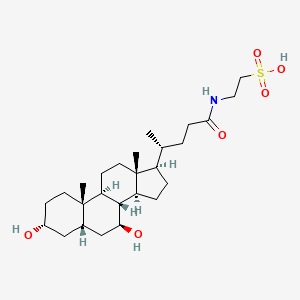| Oshitari T et al. |
Increased expression of phosphorylated c-Jun and phosphorylated c-Jun N-terminal kinase associated with neuronal cell death in diabetic and high glucose exposed rat retinas. |
2014 |
Brain Res. Bull. |
pmid:24333191
|
| Shen S et al. |
Ursolic acid induces autophagy in U87MG cells via ROS-dependent endoplasmic reticulum stress. |
2014 |
Chem. Biol. Interact. |
pmid:24802810
|
| Xavier JM et al. |
Tauroursodeoxycholic acid increases neural stem cell pool and neuronal conversion by regulating mitochondria-cell cycle retrograde signaling. |
2014 |
Cell Cycle |
pmid:25483094
|
| Ishimura S et al. |
Reduction of endoplasmic reticulum stress inhibits neointima formation after vascular injury. |
2014 |
Sci Rep |
pmid:25373918
|
| Noailles A et al. |
Microglia activation in a model of retinal degeneration and TUDCA neuroprotective effects. |
2014 |
J Neuroinflammation |
pmid:25359524
|
| Laukens D et al. |
Tauroursodeoxycholic acid inhibits experimental colitis by preventing early intestinal epithelial cell death. |
2014 |
Lab. Invest. |
pmid:25310532
|
| Park SW et al. |
Rab11, but not Rab4, facilitates cyclic AMP- and tauroursodeoxycholate-induced MRP2 translocation to the plasma membrane. |
2014 |
Am. J. Physiol. Gastrointest. Liver Physiol. |
pmid:25190474
|
| Cha BH et al. |
The role of tauroursodeoxycholic acid on adipogenesis of human adipose-derived stem cells by modulation of ER stress. |
2014 |
Biomaterials |
pmid:24424209
|
| Myronovych A et al. |
Vertical sleeve gastrectomy reduces hepatic steatosis while increasing serum bile acids in a weight-loss-independent manner. |
2014 |
Obesity (Silver Spring) |
pmid:23804416
|
| Hamano M et al. |
Lipid overloading during liver regeneration causes delayed hepatocyte DNA replication by increasing ER stress in mice with simple hepatic steatosis. |
2014 |
J. Gastroenterol. |
pmid:23512345
|
| Simoni P et al. |
A new point-of-care portable immunosensor for non-invasive assessment of oro-ileal transit time by oral fluid tauroursodeoxycholate measurement after its oral load. |
2013 Jul-Aug |
J Pharm Biomed Anal |
pmid:23587552
|
| Wang R et al. |
Defective canalicular transport and toxicity of dietary ursodeoxycholic acid in the abcb11-/- mouse: transport and gene expression studies. |
2013 |
Am. J. Physiol. Gastrointest. Liver Physiol. |
pmid:23764895
|
| Shin J et al. |
SIRT7 represses Myc activity to suppress ER stress and prevent fatty liver disease. |
2013 |
Cell Rep |
pmid:24210820
|
| Yao XH et al. |
Prenatal ethanol exposure causes glucose intolerance with increased hepatic gluconeogenesis and histone deacetylases in adult rat offspring: reversal by tauroursodeoxycholic acid. |
2013 |
PLoS ONE |
pmid:23544086
|
| Cai Z et al. |
Endoplasmic reticulum stress participates in aortic valve calcification in hypercholesterolemic animals. |
2013 |
Arterioscler. Thromb. Vasc. Biol. |
pmid:23928865
|
| Mališová L et al. |
Ursodeoxycholic acid but not tauroursodeoxycholic acid inhibits proliferation and differentiation of human subcutaneous adipocytes. |
2013 |
PLoS ONE |
pmid:24312631
|
| Gaspar JM et al. |
Tauroursodeoxycholic acid protects retinal neural cells from cell death induced by prolonged exposure to elevated glucose. |
2013 |
Neuroscience |
pmid:24012838
|
| Xu H et al. |
The ER luminal binding protein (BiP) alleviates Cd(2+)-induced programmed cell death through endoplasmic reticulum stress-cell death signaling pathway in tobacco cells. |
2013 |
J. Plant Physiol. |
pmid:23867017
|
| Takeda N et al. |
Altered unfolded protein response is implicated in the age-related exacerbation of proteinuria-induced proximal tubular cell damage. |
2013 |
Am. J. Pathol. |
pmid:23871833
|
| Fang L et al. |
Involvement of endoplasmic reticulum stress in albuminuria induced inflammasome activation in renal proximal tubular cells. |
2013 |
PLoS ONE |
pmid:23977286
|
